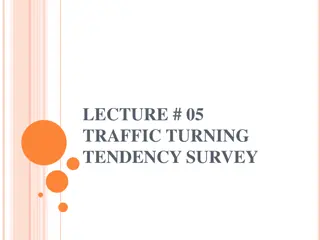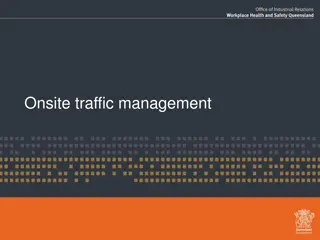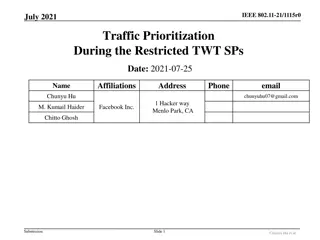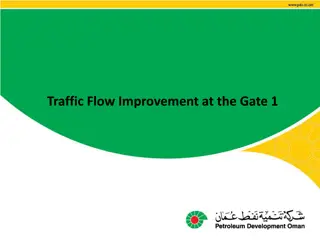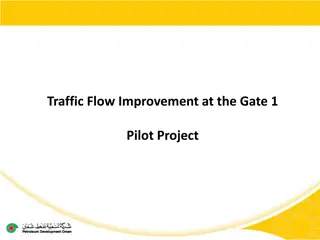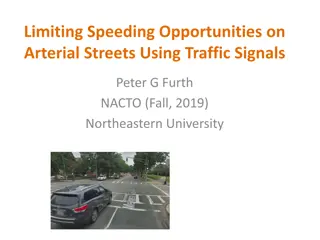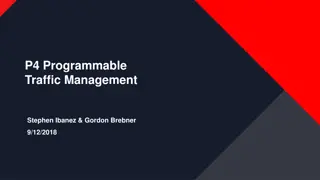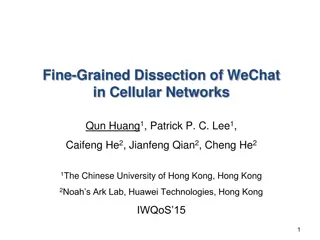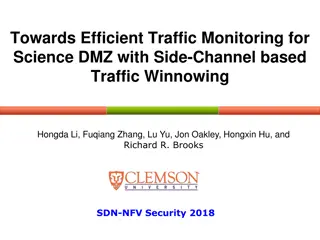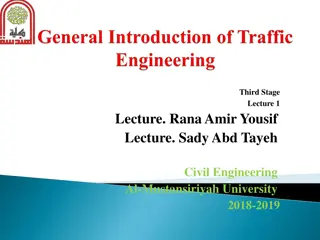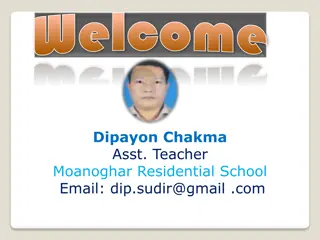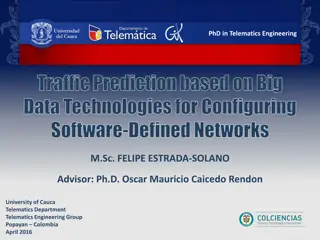Understanding the Role of NCUTCD in Traffic Control Management
The National Committee on Uniform Traffic Control Devices (NCUTCD) plays a crucial role in setting standards and guidelines for traffic control devices. Established in 1980, it advises the Federal Highway Administration (FHWA) on the Manual on Uniform Traffic Control Devices (MUTCD), facilitating revisions and improvements to enhance roadway safety. Through a structured consensus-building process, NCUTCD leverages research and expert input to recommend changes and updates to traffic control devices, ensuring they align with evolving transportation needs.
Download Presentation

Please find below an Image/Link to download the presentation.
The content on the website is provided AS IS for your information and personal use only. It may not be sold, licensed, or shared on other websites without obtaining consent from the author. Download presentation by click this link. If you encounter any issues during the download, it is possible that the publisher has removed the file from their server.
E N D
Presentation Transcript
The MUTCD and the Role of NCUTCD INSERT NAME AND COMPANY National Committee on Uniform Traffic Control Devices INSERT DATE
Agenda NCUTCD History & Role MUTCD Current Resources & Likely Content of the New MUTCD FAQ s Official Interpretations Interim Approvals Official Experiments The Next Edition of the MUTCD? 2
NCUTCD (www.ncutcd.org) National Committee on Uniform Traffic Control Devices, formed 1980 Predecessor committees formed in 1931; wrote the 1935 - 1971 MUTCD editions Since 1971, committees have advised FHWA on MUTCD initiating recommended changes, reviewing proposals, submitting comments on rulemakings 3
NCUTCD Focuses on standards and guidelines for traffic control devices Recommends proposed revisions to the MUTCD to FHWA (organization responsible for the Manual) Provides forum for professionals with diverse backgrounds to exchange information 4
NCUTCD Process Consensus-building process over time Utilize research/experimentation to improve existing devices or recommend new ones Procedure Technical Committee reviews completed research and/or experimentation Draft proposal by technical committee Review by sponsoring organizations Revisions by technical committee Discussed and voted on by Council If approved, submitted to FHWA 5
NCUTCD Structure Governing By-laws Sponsoring Organizations (19) Council (votes on proposals) 37 voting members representing 19 sponsoring organizations Executive Board 8 Technical Committees 250+ Professional Volunteer Members from cities, states, counties, academia, industry, user groups - open to those engaged in practices related to TCD s and roadway safety 7
NCUTCD Organization Council (37 members) Group I: Agencies (22 members) 8 AASHTO 8 ITE 3 APWA 3 NACE Executive Board Secretary S p o n s o r i n g O r g a n i z a t i o n s Edit Group II: National Organizations (8 members) 1 APTA 1 AREMA 1 AAR 1 APBP 1 ASCE 1 IACP 1 IBTTA 1 IMSA Research T e c h n i c a l C o m m i t t e e s Regulatory and Warning Signs Guide and Motorist Information Signs Technical Committees (8 committees) Markings Group III: Public (4 members) 1 AAA 1 HFR 1 LAB 1 NSC Signals Temporary Traffic Control Task Forces Railroad and Light Rail Transit Highway Grade Crossings Group IV: Industry (3 members) 1 AHUA 1 ARTBA 1 ATSSA Bicycle
NCUTCD (sponsoring organizations) American Assoc. of State Highway & Transportation Officials (AASHTO) American Automobile Association (AAA) American Public Transportation Association (APTA) American Public Works Association (APWA) American Railway Engineering & Maintenance of Way Association (AREMA) American Road & Transportation Builders Association (ARTBA) American Society of Civil Engineers (ASCE) American Traffic Safety Services Association (ATSSA) Association of American Railroads (AAR) Association of Pedestrian and Bicycle Professionals (APBP) American Highway Users Alliance (AHUA) Human Factors Resources (HFR) Institute of Transportation Engineers (ITE) International Assoc. of Chiefs of Police (IACP) International Bridge, Tunnel & Turnpike Association (IBTTA) International Municipal Signal Association (IMSA) League of American Bicyclists (LAB) National Association of County Engineers (NACE) National Safety Council (NSC) 10
Evolution of the MUTCD Over 80 years & 10 Editions Working Toward 20?? MUTCD Future 1935
Frequently Asked Questions (FAQs) The FHWA's MUTCD Team receives questions daily about a wide variety of issues involving traffic control devices and the MUTCD As a resource to practitioners, some of the most frequently-asked questions, along with the answers to those questions, are posted on the FAQs web page of the MUTCD web site All of the FAQs are relevant to the 2009 MUTCD 14
Official Interpretations Purpose is to allow the FHWA to provide additional clarity to practitioners when a provision in the MUTCD is difficult to understand or when situations arise where complying with a particular provision would be challenging or impractical An Official Interpretation is not a revision to the MUTCD and should be considered as FHWA policy guidance or FHWA's recommendation of appropriate or best practice 15
Official Interpretations A total of 83 official interpretations have been issued since the 2009 MUTCD was published, with the following distribution by parts: Part 1. General 2 Part 2. Signs 17 Part 3. Markings 5 Part 4. Highway Traffic Signals 27 Part 5. Low-Volume Roads 1 Part 6. Temporary Traffic Control 16 Part 7. School Areas 1 Part 8. Grade Crossings 7 Part 9. Bicycle Facilities 7 16
Interim Approvals Purpose is to allow the interim use, pending official rulemaking, of a proven successful new traffic control device, a revision to the application or manner of use of an existing traffic control device, or a provision not specifically described in this Manual It is issued by official memorandum and includes technical conditions for use (design, placement, etc.) 17
Interim Approvals Criteria for a new device to be considered for FHWA issuance of an Interim Approval: Successful experimentation and/or research in diverse geographic regions or conditions (not just a single jurisdiction) Assessment of relative risks, benefits, costs, impacts, and other factors FHWA intention to propose the device for the next edition of MUTCD and a high likelihood of its adoption in the Final Rule 18
Interim Approvals - Requirements Standard: A jurisdiction, toll facility operator, or owner of a private road open to public travel that desires to use a traffic control device for which FHWA has issued an interim approval shall request permission from FHWA. Guidance: The request for permission to place a traffic control device under an interim approval should contain the following: A. A description of where the device will be used, such as a list of specific locations or highway segments or types of situations, or a statement of the intent to use the device jurisdiction-wide; B. An agreement to abide by the specific conditions for use of the device as contained in the FHWA s interim approval document; C. An agreement to maintain and continually update a list of locations where the device has been installed; and 19
Interim Approvals - Requirements D. An agreement to: 1. Restore the site(s) of the interim approval to a condition that complies with the provisions in this Manual within 3 months following the issuance of a final rule on this traffic control device; and 2. Terminate use of the device or application installed under the interim approval at any time that it determines significant safety concerns are directly or indirectly attributable to the device or application. The FHWA s Office of Transportation Operations has the right to terminate the interim approval at any time if there is an indication of safety concerns. 20
Interim Approvals A total of 20 Interim Approvals since 2003; nine have been issued since the 2009 MUTCD was published: Alternative Traffic Signal Photo Enforced sign-Nov 2010 Alternative Electric Vehicle Charging sign - April 2011 Green Colored Pavement for Bike Lanes - April 2011 Alternative U.S. Bicycle Route sign - June 2012 Bicycle Signal Faces - Dec 2013 Optional Use of 3-Section FYA Signal Faces-Aug 2014 Optional use of an Intersection Bicycle Box Oct 2016 Alt. Signal Warrant 7 Crash Experience Feb 2017 Optional Use-Two-Stage Bicycle Turn Box June 2017 21
Interim Approvals Two interim approvals issued prior to the 2009 MUTCD that were in effect until recently: Clearview font on guide signs Rescinded 2016 Rectangular Rapid Flashing Beacons Suspended 2016 - for new requests; agencies already approved are grandfathered to continue use, if desired. 22
Interim Approvals The following are the number of agencies (as of 1/5/2017) that have requested and received the FHWA s permission to use these interim approved devices: Clearview font on guide signs 30 Rectangular Rapid Flashing Beacons 188 Alternative Traffic Signal Photo Enforced sign 5 Alternative Electric Vehicle Charging sign 12 Green colored pavement for bike lanes 97 Alternative U.S. Bicycle Route sign 13 Bicycle Signal Faces 28 Three Section FYA 17 Intersection Bicycle Box - 9 23
Official Experiments/Rulings Goal- to seek the best traffic control devices Purpose to allow practitioners to test new or innovative traffic control devices or applications: To see if they perform more effectively than the devices in the MUTCD; or Because there is no device in the MUTCD that addresses the situation being studied 24
Official Experiments A State DOT or a local agency must write a letter to the FHWA requesting to conduct an experiment Request must include a research plan describing what data will be collected, how it will be collected, and how it will be analyzed Key is for experimental plan to produce data for objective (not subjective) results with quantifiable performance measures Experiment may begin only after written approval from the FHWA Successful experimentation is utilized by NCUTCD & FHWA to recommend updates to the Manual 25
Official Experiments A total of 176 official experiments have been approved since the 2008 NPA for the 2009 MUTCD was published, with the following distribution by parts: Part 1. General 0 Part 2. Signs 28 Part 3. Markings 27 Part 4. Highway Traffic Signals 29 Part 5. Low-Volume Roads 0 Part 6. Temporary Traffic Control 13 Part 7. School Areas 0 Part 8. Grade Crossings 4 Part 9. Bicycle Facilities 75 26
Why are Official Experiments Important? A jurisdiction that installs a device or application that is not in the MUTCD, that violates MUTCD requirements, or that has not received Interim Approval status, without first obtaining FHWA experimentation approval, faces these risks: Potential legal liability if a crash occurs Potential loss of Federal-Aid funding 27
Estimated Time Line for 20?? Edition Based on MUTCD Rulemaking being treated as a Significant Regulatory Action: [Speculative to explain timeframe; assumes things go relatively smoothly] At each meeting, NCUTCD meets for generating recommendations and sends to FHWA for the next NPA 6 months - FHWA Completes final draft of NPA to update MUTCD, including economic analysis of proposed changes 5 months - Internal, OMB and OST Reviews 2 months - Publish NPA in Federal Register 6 months - docket comment period 12 months - Finalize the MUTCD & Federal Register notice 4 months - Internal, OMB and OST Reviews 5 months - Publish the Final Rule for a new edition of the MUTCD 40 months + 24 months for state adoption 28
Estimated Time Line for Next Edition Smooth Time Line Up to 64 months 29
Next Steps for NCUTCD Continue reviewing research/experimentation and recommending MUTCD revisions/improvements Identify and eliminate redundant or unnecessary text Reorganize content where opportunities for improving flow are identified Reassess each standard and retain, delete or downgrade Assist FHWA by reviewing and commenting on requests for interpretation and new devices Urge FHWA to continue use of Interim Approvals 30
Next Steps for NCUTCD Ideas from 2013 Request for Comment (smart search apps; cross indexing; fact sheets; new figures or tables; expanded hot links, etc.) Recommendations from NCUTCD strategic plan and vision - Focus on ideas for enhancing future editions - Encourage FHWA to take actions based on RFC and comments received Request research and monitor results for changes to the Manual 31
20?? MUTCD A new edition of the MUTCD, with new devices and applications, is coming, but Unsure when! No indication it will move forward under the new administration, until ???? Meanwhile, keep an eye out for additional Interim Approvals, Official Interpretations and perhaps small revisions to the 2009 edition (http://mutcd.fhwa.dot.gov) 32
Thank you! INSERT NAME? INSERT TITLE? INSERT COMPANY NAME? INSERT PHONE NUMBER? INSERT EMAIL ADDRESS Acknowledgements to ITE Professional Development & FHWA for some of content. 33
Thank you! If interested in getting involved or becoming a member, visit: (www.ncutcd.org) Questions? 34



